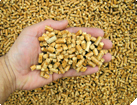Energy
Designing homes to conserve energy and use it efficiently, from sources that cause least environmental harm.
Bioenergy and Biofuels
Solid, liquid and gaseous biofuels have the potential to meet a lot more of our energy demands. In the construction sector they can be used to fuel vehicles and generators and can be used in some domestic space heating and water heating appliances.
On this page:
- Solid biofuel
- Liquid biofuels
- Biogas
- Environmental benefits
Solid biofuel
Solid biofuel in the form of firewood, wood chips or wood pellets is commonly used in residential and commercial applications for the production of heat.
Pellets are made from wood shavings and sawdust with a standardised density and moisture level, which means that they burn with lower emissions than logs. (Some low emission pellet burners can be used in areas where new wood burners are not permitted, but this depends on the local authority.)
A few models of wood pellet burner can heat water through a wetback.
Liquid biofuels
Liquid biofuels have the potential to replace petroleum-based fuels in many uses, chiefly transport and machinery. But there are other uses too – architects and designers whose client brief includes indoor/outdoor flow and lifestyle might consider outdoor fires that run on bioethanol, for example. The most widely available liquid biofuels in New Zealand are biodiesel (an alternative to diesel) and bioethanol (an alternative to petrol).
Biofuels are produced from biomass, and this can range from plants grown especially for the purpose, to waste products from industry and commerce, or from forestry and wood processing operations.
In New Zealand biodiesel has been produced from biomass such as used cooking oil, tallow, and canola oil from rapeseed grown as a break-crop (not competing with food production).
Z Energy Ltd built a biodiesel plant at Wiri, Auckland, the first commercial-scale biofuel production facility in New Zealand. The biodiesel was produced from inedible tallow, a meat industry by-product. Unfortunately, changes in global prices for tallow (a price rise) and diesel (a price fall) made production uneconomic and the plant has been closed.
Bioethanol is produced from whey. However, the production of advanced liquid biofuels from the residues of forestry and wood processing has the greatest potential as a source of transport fuel in New Zealand.
The Wood Fibre Future report (2020) identified opportunities for using New Zealand’s plantation forestry biomass to help the country move to a zero-carbon economy. Biofuels could be produced that would reduce the need for imported fossil fuels.
While a lot of research is going into transport biofuel development both here and around the world, running vehicles and machinery on biofuels is not a new idea – at the Paris Exhibition of 1900 there was a working engine that ran on peanut oil.
Currently available transport biofuels are often used in a blend with petroleum-based petrol or diesel. Bioethanol-blended petrol is available from a few petrol stations in blends of 10% bioethanol (E10). This blend results in 5–6.5% lower greenhouse gas emissions per litre compared with standard petrol. B5 is a biodiesel blend with 5% biodiesel. Blends such as B5 must meet the same requirements as petroleum diesel, such as those relating to performance in cold temperatures.
All solid and liquid biofuels should be stored in closed containers, in cool and dark spaces, protected from the weather to reduce the moisture they may draw from the air as moisture may degrade the quality of the fuel and thus its efficiency of use.
Biogas
Biogas from landfills and sewage/wastewater treatment facilities is produced around the country.
For example, at the Redvale Landfill and Energy Park north of Auckland, landfill gas (which is approximately 50% methane) is used to generate electricity. Around 36 million cubic metres of methane is taken out of the landfill each year. Redvale’s current energy generation has the capacity to power 14,000 homes, with a possibility of powering up to 18,000 homes by 2025. Once closed, Redvale will continue to generate energy (at a declining rate) for up to 30 years. Capturing methane is especially important from a climate change perspective – methane emissions have 25 times the warming potential of CO2 emissions over the longer term.
There is a facility at Reporoa that processes food scraps into biogas and fertilizer. This is the first facility of its kind in New Zealand. The country produces an estimated 327,000 tonnes of food waste each year. The food waste comes from various sources including Auckland (the latter using construction trucks that usually return to the region empty after taking construction aggregate to Auckland).
Biogas can also be produced on farms from manure. The gas can be used to run machinery directly to replace mineral diesel or can be used to generate electricity. One biogas system on a Landcorp dairy farm in Canterbury produces enough gas to meet a third of the farm’s energy need.
Beca, EECA, Firstgas Group and Fonterra are supporting research into the potential for raw biogas to become a substitute for natural gas with appropriate treatment. (Taranaki-based Firstgas owns the gas transmission network in New Zealand.) Biogas is used as a substitute for natural gas overseas.
Environmental benefits
The various biofuels and blends can produce from around 4% to over 80% less greenhouse gas emissions compared to mineral diesel or petrol. The carbon dioxide produced when the biofuel is burnt is effectively balanced by the carbon dioxide the biomass (such as the rapeseed crop) earlier took out of the atmosphere.
In its advice to Government released in June 2021, the Climate Change Commission said that “Bioenergy (such as biogas, liquid biofuels, wood pellets) and hydrogen, hold promise and can either be produced domestically or imported. Our analysis indicates that these fuels have significant potential for reducing emissions…”
(Photograph courtesy Bioenergy Association of NZ)/
Updated: 20 February 2023


